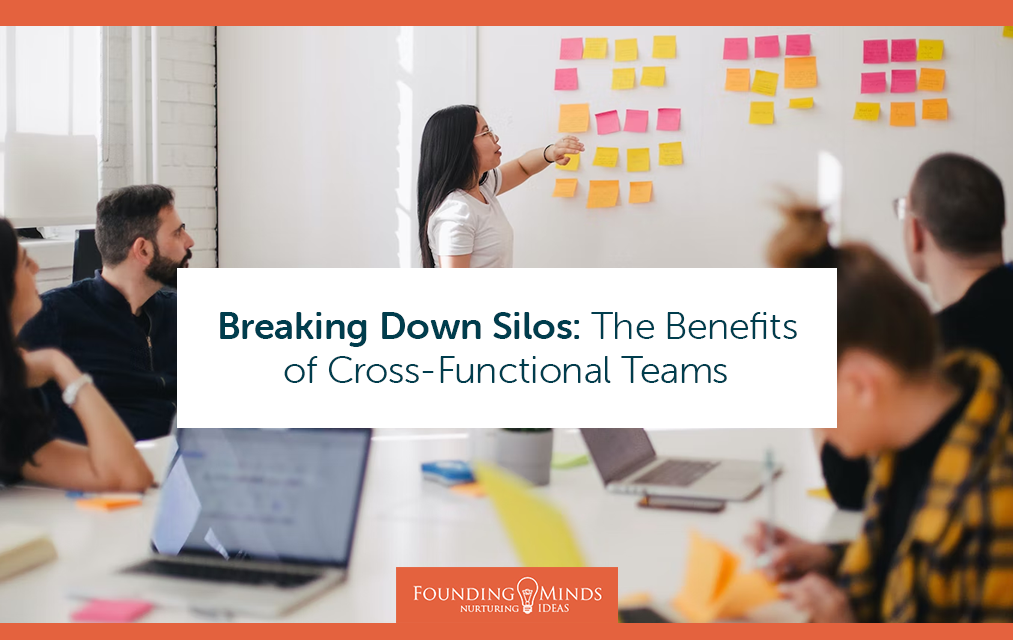
In today’s rapidly evolving business landscape, organizations recognize the need to become more responsive to change and better equipped to meet the ever-evolving needs of their customers. In such a scenario, silos have been a challenge in organizations, creating communication breakdowns and hindering collaboration between departments.
However, with the rise of agile methodologies and the growing importance of delivering value to customers, there has been an increasing recognition of the benefits of breaking down silos and embracing cross-functional teams in project management. Organizations can improve communication, increase efficiency, and drive innovation by breaking down barriers between departments and fostering collaboration.
In this blog, we will explore why breaking down silos and forming a cross-functional team at Founding Minds became increasingly important in today’s fast-paced business environment and how it can benefit customer needs.
What are Silos in Organizations?
Silos in organizations refer to the division of departments or teams that operate independently, with little or no communication or collaboration with other departments or teams. Silos can be physical or organizational, but in either case, they create barriers between departments, hindering communication and collaboration. As a result, this can lead to misaligned goals, duplicated efforts, and inefficiencies in the workplace. In some organizations, silos can even lead to competition between departments rather than a focus on the overall goals of the organization.
With the trend towards more agile and customer-centric methodologies, removing silos is essential to align the entire organization towards a common goal of delivering value to customers. As such, breaking down silos and fostering cross-functional collaboration is increasingly seen as a means of improving communication, efficiency, and innovation within organizations.
At Founding Minds Software (FMS), breaking down the silos was crucial for promoting interdepartmental collaboration and communication, enabling departments to work together more efficiently and effectively. This was necessary to facilitate the adoption of agile approaches, which rely on cross-functional teams working in tandem to develop and deliver products and services much more quickly. By breaking down the silos, FMS was able to create an environment where team members could work together while utilizing agile practices and reap the benefits that it offers.
The Benefits of Autonomous Cross-Functional Teams

Autonomous cross-functional teams are teams that are made up of members from different departments or functions within an organization and are given the independence and resources to achieve specific goals.
Smaller, autonomous, cross-functional teams are particularly advantageous when team members are unfamiliar with one another. When cross-functional teams come together, they can experience a stronger sense of unity, especially amongst different departments. This collaborative approach can lead to increased understanding and appreciation for an organization’s diverse roles and responsibilities.
Employee engagement is essential for the success of any organization. Unfortunately, a recent Gallup poll reveals that only 33% of employees are actively engaged. This troubling statistic highlights the importance of creating a positive work environment that encourages and motivates employees to perform at their best, and establishing cross-functional teams is one effective way to achieve this.
For Founding Minds (FMS), such a collaborative effort meant significant results for our primary objective – project incubation. Today, a cross-functional and agile team approach enables FMS to ensure that all facets of the project are addressed and that results are achieved on time. With a focus on collaboration, communication, and innovation, FMS is poised to deliver successful projects for its clients.
Here are some other prominent benefits of having such a flexible and cross-functional approach to problem-solving.
- Increased efficiency: Autonomous teams can make decisions and take action quickly without having to wait for approval from higher-ups, resulting in increased efficiency and reduced delays.
- Improved collaboration: Cross-functional teams bring together diverse perspectives and skills, leading to more creative and innovative solutions to problems.
- Better alignment with company goals: By giving teams more ownership, organizations can better align their efforts with overall company goals.
- Increased accountability: Autonomous teams are accountable for their results, which can lead to higher motivation and engagement among team members.
- Improved communication: Cross-functional teams can build stronger relationships and improve communication between departments, breaking down silos and reducing the risk of misaligned goals.
- Increased customer focus: Autonomous teams allow organizations to be more agile and respond quickly to customer needs, improving customer satisfaction and loyalty.
The benefits of utilizing autonomous cross-functional teams for project management have made them a highly sought-after approach. It is well-received by industry professionals, who often recommend and vouch for its effectiveness.
“In the early stages of my career, I wondered whether being part of a cross-functional team and adopting an agile approach would benefit the organization and individual. But now, I realize it’s been a game-changer.”
– Chandra Kishore, Principal Consultant.
A Rising Tide Raises All Ships

Of course, breaking the silos isn’t a process without its challenges. It involves adapting to agile methodology, defining roles and responsibilities, creating effective communication and conflict management strategies, and fostering trust and collaboration between teams. While it can be a difficult process, the rewards of breaking the silos and working in cross-functional teams are worth the effort.
Cross-functional teams are incredibly effective in boosting visibility, communication, and understanding across an organization. By utilizing agile tools such as daily check-ins and team sprints, cross-functional teams can foster collaboration between departments, breaking down silos and strengthening relationships.
These teams further provide an opportunity for members to hone their leadership skills, such as problem-solving, communication, and decision-making, by allowing them to work in different roles and gain a better understanding of the tasks at hand. Ultimately, leveraging cross-functional teams helps organizations such as Founding Minds to achieve greater productivity and efficiency.
Final Words
Removing silos and setting an organization on the path to success, cross-functional teams can be a powerful asset when it comes to optimizing collaboration, communication, and operational efficiency. Founding Minds understands the significance of this and keeps cross-functional teams at the center of all primary operations. Our teams can promote innovation and customer-centricity by bridging the gaps between departments. Moreover, due to their capacity for swift and accountable decision-making, our cross-functional teams have become a popular choice for our client’s project management.
With the array of benefits it offers, organizations that leverage this approach will be well-positioned to respond to the ever-evolving market demands and deliver value to their customers. Realizing this, Founding Minds is proud to be at the forefront of utilizing such agile approaches, ensuring successful projects for our clients for years to come.

